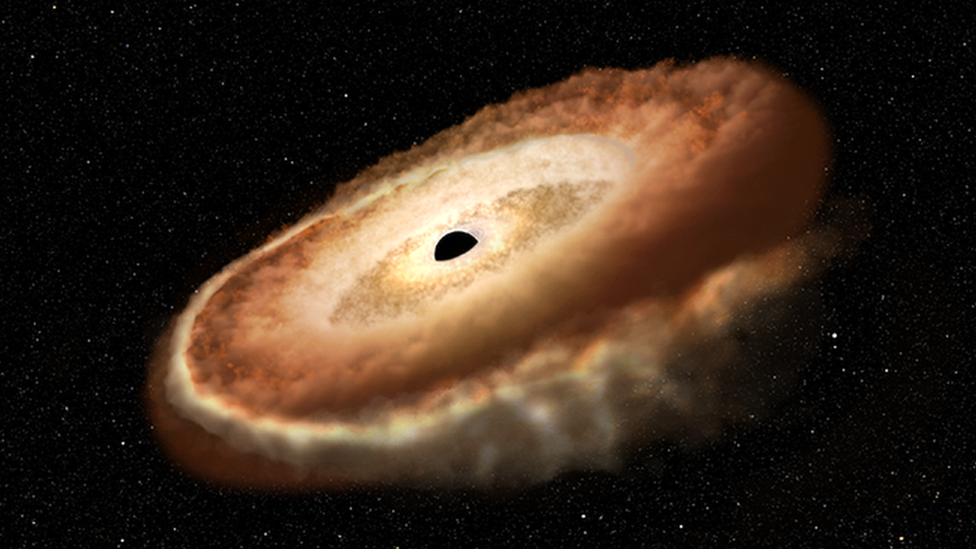Hubble telescope: Supermassive black hole caught eating a star!
- Published
- comments

Mmm, what a tasty looking doughnut!
The life of a star is pretty dramatic - they're formed when space dust starts bonding together, they give life to solar systems and can burn brightly for millions of years.
And sometimes, very rarely, they get eaten by supermassive blackholes!
Scientists at Nasa managed to catch this happening recently, through the Hubble Telescope.
They saw a black hole turning a star into what looked like a huge doughnut, before swallowing it whole.
But black holes are notoriously messy eaters - they spew out radiation while they're chowing down, and that's what scientists are able to see and analyse.
The process is called a 'tidal disruption event', and according to Nasa they are one of the most complex and violent things that happen in our known universe.
These images show the different stages of the tidal disruption event
A black hole is actually a dying star itself
It's a star that has collapsed inward under the pressure of its own weight
The pull of gravity from its centre becomes so strong that even light can't escape, which is why it looks black
It essentially becomes a super massive vacuum cleaner - sucking in stars, planets or anything that gets too close - or a bit like when you pull the plug in the bath
Black holes are also invisible, technically speaking, which has meant it has been very tricky for scientists to capture them on camera
As things get sucked into the black hole the radiation energy bursts out from behind it, creating light
Most galaxies are thought to have a supermassive black hole at their centre
How does a black hole 'burp'?
I can see the light!
Researchers think that by studying the observations, they'll be able to learn more about what happens during such an event.
But the one they've seen isn't happening right now. It's 300 million light years away, which means what they've seen actually happened millions of years ago.
This is because the light that's emitted takes a long time to become visible to our telescopes. But now that it has, the scientists can study it and look for clues about what happened to the star.
This is an illustration of what a tidal disruption event in 2021 looked like
This isn't the first time an event like this has been captured, however.
More than 100 tidal disruption events have been observed by scientists, including one in 2021 that Nasa scientists spotted happening in another galaxy.
The difference this time though, is that the Hubble observed it happening in ultraviolet (UV) light, as opposed to X-ray light.
X-rays and UV rays are forms of electromagnetic radiation, like visible light is too
They move in waves and carry energy from one place to another
X-rays are higher energy than UV rays, and usually come from much hotter sources
Information from the Royal Society of Astronomy
UV light can be used to do lots of other really cool things too, like find hidden evidence at crime scenes such as fingerprints!
Emily Engelthaler at the Center for Astrophysics at Harvard University explained that observing the black hole using UV light can give us a lot more information about event: "We're excited because we can get these details about what the debris is doing. The tidal event can tell us a lot about a black hole."
When the black hole started to consume the star, it warped the gases that formed it into a doughnut shape.
This area, known as a torus, is the size of the solar system and is swirling around a black hole in the middle.
- Published17 January 2023
- Published27 January 2023
- Published1 September 2022
